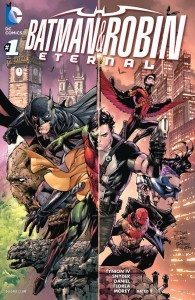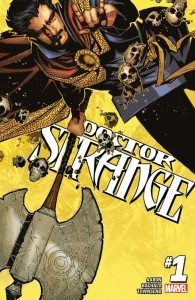Continuity is becoming an increasingly thorny concept in superhero comics. After more than 50 years of building up characters, concepts and unique worlds, both Marvel and DC have begun to reevaluate the way they approach continuity in vastly different ways.
With the New 52 in 2011, DC vastly opted to reset continuity entirely, keeping some story elements, seemingly chosen at random, and jettisoning the rest before slowly rebuilding things in a setting less indebted to decades past stories. Marvel, instead has used Secret Wars and Battleworld as a way to much more selectively address continuity, taking the concepts that have worked best from various parts of the company’s publishing history to make a sort of “Best Of” new Marvel Universe, one that appeals equally to nostalgia and the company’s slate of multimedia properties.
Two comics launched this week, Dr. Strange #1 and Batman & Robin Eternal #1 address those separate takes on comics most enduring storytelling elements in almost diametrically opposed ways.

In many ways, Batman and Robin Eternal #1 is addressing one of fans’ most prevalent complaints about the New 52, which is the way the relaunch removed the notion of legacy from the DC Universe. DC’s heroes and villains had endured for generations, with sidekicks taking up the mantles of heroes, in some cases eventually being replaced by their contemporaries or sidekicks themselves.
This issue focuses primarily on the idea of Batman’s wards. Dick Grayson, Tim Drake, and Jason Todd all team up at the issue’s beginning and characters such as Harper Row, Stephanie Brown, and the long-missing Cassandra Cain all either appear or are referenced throughout the issue. It’s the first time the Batman franchise has payed this much attention to the long bench of characters since the relaunch and that, at least is impressive.
The rest of the issue is, well, not so impressive. James Tynion IV writes the issue and is co-credited for the story with Scott Snyder. Much like his previous Batman work and his work on the first Batman Eternal series, Tynion lacks a distinctive voice for this franchise. His Dick Grayson lacks the fun, sexy, almost James Bond-esque devil-may-care attitude that defines the character and focusing on the character does the issue no favors. Under his pen, Grayson soullessly wanders through a Spyral mission, which’s importance is never explained, only to deal with a sudden reminder of an adventure he’d long since almost forgotten.
This is just rote, grating storytelling at its worst. Tynion is just answering a question he’s not giving the readers a reason to ask and that lack of momentum shows, never more so than when he tries to ratchet up the tension in a fight between Dick and Cassie. Worse, Tynion’s not helped by artist Tony Daniel. Daniel’s style is divisive, a blend of Jim Lee and Todd McFarlane, but at his best, like in books such as Batman RIP, he can deliver kinetic, iconic panels that are an equal blend of gritty darkness, and memorable brutality. Here. he’s almost startling lazy.
He fails to provide details to faces in several key panels and scenes featuring Harper Row almost look like he traced Kenneth Rocafort’s art. It’s haphazard and distracting in a book that should be anything but. It all gives the distinct impression that none of the characters’ motives are clear. No one’s actions have weight. We’re thrown into a conspiracy we as readers are given no reason to care about and the issue’s cliffhanger is so similar to the “we know he didn’t do it” twist that the first Batman Eternal leaned on that it’s frankly, kind of embarrassing.
DC asks a lot of readers when they release a weekly comic and, again, they’re not offering a properly baited hook. Tynion and Snyder are clearly depending on readers being intrigued by an unexplored piece of New 52 continuity, an untold story of Dick’s time as Robin, but in a comic where no one’s acting like they should, that’s not a particularly compelling hanger to place your narrative on.

There are a lot of continuity questions readers don’t know the answers to going into this week’s Dr. Strange #1. The last time we saw the Sorcerer Supreme he was (SPOILER) murdered by Dr. Doom for his betrayal in Secret Wars #4. As such, it’s not entirely clear what Dr. Strange writer Jason Aaron is drawing from for this debut issue.
The first pages of the book seem to imply this is a doctor who is long past the days of his training and well entrenched as Sorcerer Supreme but his behavior’s a little off. He’s friendly and whimsical when more recently he’s been cold, monstrous and morally compromised. More than anything, it’s clear that the biggest influence on this Strange is the Marvel Cinematic Universe.
This Strange is an only loosely disguised Robert Downey Jr., all swagger, humor, and never-quite-insincere womanizing charm. It’s a Strange who ruthlessly flirts with a demon before teasing, prodding, and boasting to a Brooklyn hipster. This isn’t the Strange readers have grown to know. This isn’t the Strange who sold his soul for a chance to save the world. Marvel spent years building Dr. Strange to be the character he becomes before Secret Wars and this incarnation bares no resemblance to that compelling figure.
It’s not exactly a tone that particularly suits Aaron, a writer who tends to do a better job with amoral badasses than relentlessly chatty sorcerers. The best moments of the script here are when Aaron addresses the issues that make Strange tick. There’s a real focus on the physical aspects of magic here. Aaron uses first person narration to show the physical skills and rigorous pain and toll casting takes on Strange’s body. That focus on the body extends to the art as well.
Chris Bachalo is well known for his stylistic, manga-inspired pencils and he tries to instill a sense of losing ones body to forces beyond man’s control. The Eye of Agamotto appears graphically and physically on Strange’s forehead, demons infect passerby’s with tentacles and scales growing out of their skulls. It lends itself well to Aaron’s idea of magic as a physically transforming, corrupting force but Bachalo doesn’t entirely pull it off. Bachalo already draws figures with such an exaggerated style that monstrous additions feel superfluous, like gilding the lily with a tentacle. The book is strongest in its opening and closing, both of which feature Strange facing truly arcane, demonic forces rather than mildly corrupted humans.
There are some wildly good ideas in Dr. Strange #1 but it’s hard to ignore how little the character resembles who he was. Maybe by the time Secret Wars ends, we’ll have a better picture of who exactly this Dr. Strange is. For now, this story feels completely divorced from one of Marvel’s most important features, it’s long continuity, but it also has a strong chance of reaching out to a new audience.
In a time when the average person is becoming more familiar with superheroes from their appearances on TV and in theaters, DC and Marvel are finding new ways to address their long history. Batman & Robin Eternal and Dr. Strange show different options as to how that issue can be addressed or ignored, embraced or rejected. The answer is always going to rest somewhere in between those two extremes, even if that means occasionally having to remember that time Batman and Robin had to fight Alfred after he turned into a rock monster.